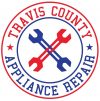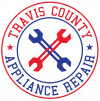Essential Tips to Maintain and Extend the Life of Your Appliances
Maintaining your appliances not only keeps them running efficiently but also extends their lifespan, saving you money on appliance repair services and replacements. Here are some practical tips to ensure your home appliances stay in top shape.
Washing Machine Maintenance
Replace Washing Machine Hoses
It’s best to replace your washing machine hoses with blow-proof ones for added safety. Before doing this, clean and lubricate the shut-off valves every spring. Dirt can build up on the valve stems and restrict their movement. Turning the valves occasionally throughout the year also helps prevent them from seizing.
Draining and Connecting Hoses
To avoid a mess, drain the hoses once they are disconnected. When connecting the new hoses, ensure each hose is connected from the correct temperature valve to the corresponding intake nozzle on the machine. After connecting, turn on the water and check for leaks.
Leveling the Washing Machine
To level the washing machine (and dryer), turn the feet in the appropriate direction to adjust them up or down. Once the machine is level, double-check for leaks to ensure everything is properly connected.
- Avoid Overloading: Overloading can strain the motor and reduce the machine's efficiency. Follow the manufacturer's load recommendations.
- Clean the Dispenser Drawers: Remove and clean the detergent and fabric softener drawers to prevent buildup.
- Check the Hoses: Inspect the water hoses for any signs of wear or leaks and replace them every five years to prevent flooding.
Dryer Maintenance
Check and adjust the dryer vent. Find the most direct path to the outside vent, but leave some slack so there is no strain on the hose. Mark the proper length and cut off the excess with a utility knife. Vacuum the hose, the vent on the machine, and the outdoor vent before reattaching the hose. Vacuum the lint screen receptacle. Keeping lint under control is critical both for cleanliness and for household safety. Clean the lint screen after every dryer cycle. You should have your dryer professionally disassembled and cleaned out every five years to prevent dryer fires.
- Clean the Lint Filter: After every load, clean the lint filter to improve airflow and prevent fires.
- Inspect the Vent: Check the dryer vent for any blockages and clean it at least once a year to maintain proper airflow.
- Avoid Overloading: Just like the washing machine, avoid overloading the dryer to ensure it works efficiently.
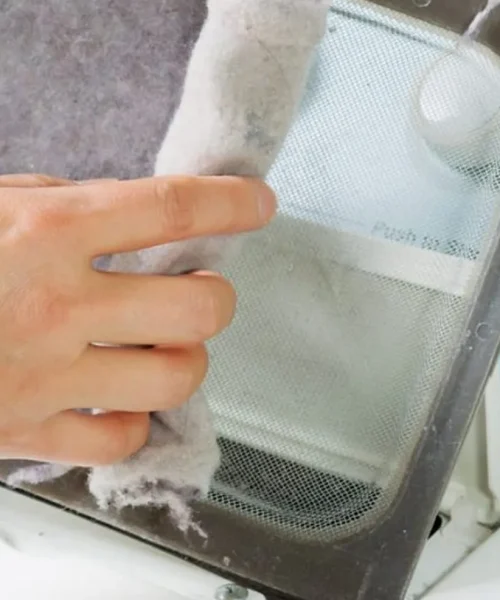
Dishwasher Maintenance
Regularly cleaning and maintaining your dishwasher can keep it running smoothly and can provide you with spotless dishes every time you run it.
Wash regularly
One of the best ways to ensure your dishwasher is free from excess buildup is by running it regularly. Running your dishwasher frequently will keep debris from settling in the bottom of the appliance, reducing how often you will need to thoroughly clean it throughout the year.
Run the dishwasher through a full cycle and empty it
This allows you to have easier access to the entire dishwasher and be able to perform the necessary maintenance correctly.
- Clean the Filter: Your dishwasher filter can get clogged with food particles. Regularly remove and clean it to keep your dishwasher working efficiently.
- Run Hot Water Before Starting: Running hot water in your sink before starting the dishwasher ensures it begins the cycle with hot water, which helps with better cleaning.
- Use the Right Detergent: Make sure you're using a detergent that's right for your dishwasher and the hardness of your water.
Inspect and clean the spinning arms
Dishwashers work by spraying water out of their spinning arms onto the dishes inside. When those arms aren’t spinning properly or the holes in them are full of buildup, they won’t thoroughly clean your dishes. Check to make sure the arms spin correctly and clean out any debris that has accumulated inside the holes with a small piece of wire, a toothpick, or small pliers.
Clean the edges and exterior
Many times the offending smells you may find coming from your dishwasher may actually be coming from the outside areas around the appliance. The edges around the door do not get washed during a regular cycle and can end up with lots of spills and pieces of food debris. A bit of regular household cleaner and a damp cloth should be enough to wipe up this yucky spot and can also be used to wash off all of the buttons and the exterior door of the appliance as well.
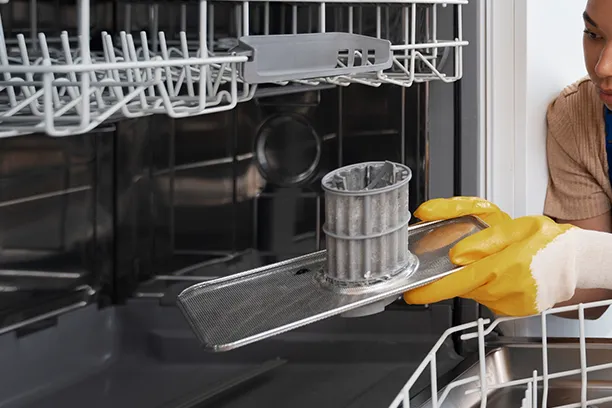
Other Parts You Should Clean:
- Under the door, on the inside.
- The flatware basket.
- The door gasket.
- The detergent dispenser.
Unclog and clean the drain At the very bottom of your dishwasher is the drain, which can be a common place where food debris, buildup, and other matter can accumulate. Leaving these obstacles near the drain will eventually create a clog, causing it to become less efficient and have a harder time cleaning. And nobody wants to find their dishes are not-so-sparkling clean. You can start cleaning the area around the drain by collecting the biggest pieces by hand, but you may have to disassemble the drain to get to some of the smaller pieces. Here’s how you can do this.
- Unplug the dishwasher.
- Take out the screws and remove the cover.
- Protect the opening to keep debris out.
- Clean out larger pieces by hand.
- Clean out smaller deposits with a brush or cloth.
- Reassemble in the reverse order.
Cleaning out around the dishwasher drain can help to ensure that dirty water is exiting the appliance adequately so the dishwasher cleans your dishes well. Use an acid to remove buildup Getting rid of the water deposits and buildup in your dishwasher is an important step to make your dishes sparkly and not dingy after a cycle. Choose one of the following acids and run them through a short cycle to get rid of excess scale:
- White vinegar
- Lemon juice
Any powdered substances should be placed in the detergent dispenser and liquids can be left in a bowl on the top rack.
Refrigerator Maintenance
Check the door seals The seals on the doors of your fridge and freezer make sure the cold air stays inside. If warm outside air is seeping into the unit, it has to work harder to keep the internal temperatures low. Make sure the seals are clean using an old toothbrush and a mixture of baking soda and water. You can also rub petroleum jelly on the seal to prolong its life. Every time you open and close the door, the seal loses some of its elasticity. If it is cracked or not adhering, you might have to replace it. You can try the “dollar bill test”: close the door with a dollar bill half in and half out. If it slips out easily while the door is closed, the seals need to be replaced.
- Clean the Coils: Did you know that the coils on your refrigerator can get really dirty? This makes the fridge work harder than it needs to. Grab a vacuum or a coil brush and clean them at least twice a year to keep things running efficiently.
- Check the Door Seals: Make sure the door seals are doing their job. A good way to test this is by closing the door on a piece of paper. If it slips out easily, you might need to replace the gasket to keep the cool air in.
- Set the Right Temperature: Keep your fridge between 37°F and 40°F, and your freezer at 0°F. This helps with energy efficiency and keeps your food safe.
Make Sure It’s Level
If your fridge or freezer isn’t level, the doors may not seal properly and could eventually warp out of place. To check, use a carpenter’s level on top of the unit. If it’s not level, adjust the appliance’s feet using a hand wrench.
Change the Water Filter
If your refrigerator has an icemaker, it likely has a water filter that needs regular replacement. Typically, you should replace the filter every six months or as recommended in the owner’s manual. Remember, water passing through a dirty filter can be dirtier than before it was “filtered.”
Clean the Condenser Coils
Condenser coils help control the temperature of your fridge or freezer, so it’s essential to keep them clean. Dust, hair, and grime can accumulate on the coils over time. Every three months, unplug the appliance and clean the coils using a vacuum cleaner and a coil brush. Your owner’s manual will help you locate the coils.
General Cleaning
Keeping both the inside and outside of your fridge clean is important for maintaining food quality. Remove all stored items and use a clean cloth to wipe down the interior, including shelves and drawers. Vinegar can be used to prevent mildew growth.
Set the Right Temperature
Set your refrigerator between 37-40 degrees Fahrenheit and your freezer at 0 degrees Fahrenheit for optimal performance.
Keep It Full
Refrigerators need “thermal mass” (items inside) to maintain low temperatures efficiently. Cold food and liquids absorb warm air when the door is opened. If your fridge is nearly empty, store some water jugs inside to help maintain the temperature.
Ice Machine Maintenance
Understanding Scale and Algae Build-Up
As ice forms on an ice machine evaporator plate, minerals separate from the water and form scale, which sticks to the surfaces of the water system components. This scale is more visible when the surfaces are dry. The color of the scale varies depending on the local water supply’s minerals: lime or calcium scale appears off-white, while iron scale is rusty red. Algae or slime growth can also occur due to air or water-borne bacteria settling in wet areas.
Removing Scale Build-Up
Scale build-up inside the barrel causes low production and poor-quality ice and must be removed. This is done by circulating a mild phosphoric acid solution throughout the water system. Always follow the cleaning instructions in the unit’s manual. Many ice machine models also provide a cleaning label inside the front panel for quick reference. Use the correct mixing solution for the cleaner. Plated evaporators require a nickel-safe cleaner, which has a weaker acidic solution to protect the plating surface. For Hoshizaki’s stainless steel evaporator plates, use a commercial ice machine cleaner with 30% or less phosphoric acid.
Sanitizing the Ice Machine
After cleaning, sanitize the unit using a commercial ice machine sanitizer or a 5% sodium hypochlorite solution (household bleach). This is especially important if algae or slime is present. The sanitizer eliminates bacteria and retards further growth. Follow the recommended mixing solution and rinse the system thoroughly after sanitizing. Clean and sanitize the storage bin at this time, and thoroughly flush the water system and bin before putting the unit back into operation to ensure clean, fresh ice.
Cleaning and Inspecting
While waiting for the cleaning solution to work, clean the condenser coils. You may need to remove a cover from the back or front to access them. Use a coil brush and a vacuum for this task. If you have trouble locating the coils, check your manual for specific instructions.
Oven Maintenance
Regular wipe-downs
It may sound simple, but regularly wiping down the exterior of your oven is one of the simplest and best ways to keep it looking shiny and new. Everyone wipes down their worktops when they become dirty, so why not incorporate the front and top of the cooker into this? Travis County and easy, yet so very effective.
Use baking trays to catch spillages
Spillages are the cause of most stains in your oven, so why not take a pre-emptive approach and catch them before they hit the oven floor? Placing a baking tray at the bottom of the oven is a great way to do this. Remember to put a baking sheet covered in foil over the tray, but make sure the foil isn’t touching any heating elements that could melt it.
Loosen grease with steam
One of the most effective ways of budging oven grease is with steam. By placing a bowl of hot water in the oven for 20 minutes at a high temperature, the steam created will loosen the dirt and make it much easier for you to wipe away using your cleaning product. Don’t forget the racks Oven racks will build up their fair share of dirt, so don’t forget to give them a good clean along with the rest of the oven. Simply placing them in the dishwasher should do the trick, but leaving them to soak in cleaning solution before using an abrasive pad will also suffice.
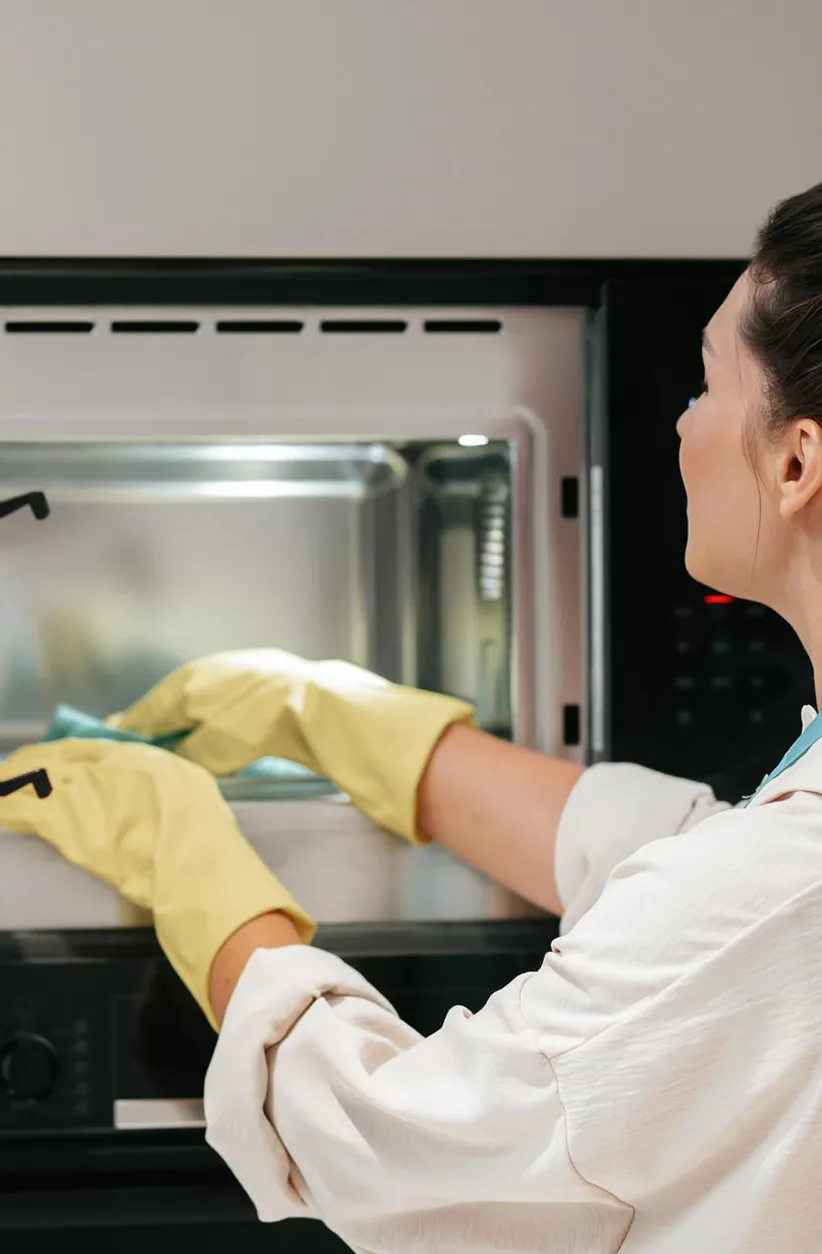
Microwave Maintenance
Keep the inside clean
By regularly wiping out the inside of your microwave, you cut down on bad smells and keep spots and corrosion from developing. Food and liquid left in the oven will continue to cook each time it’s used and will absorb the energy meant to heat up your current meal, making it less efficient. Clean any spills and splatters right away, and do a full wipe-down with a mild detergent once a week to once a month, depending on your usage.
Keep the outside clean
Dust, grease, and other residues can build up on the outside of your microwave, especially on the controls. Old stains are harder to clean than new messes, so keep your microwave looking brand new by wiping it down regularly. This includes the areas around the microwave such as the countertop or cabinet.
Use microwaveable containers
Cover your food
Never put metal in your microwave
Make sure the door closes properly
Outdoor Grill Maintenance
- Remove the cooking grates and soak them in hot, soapy water.
- Remove the barrier and do the same to them.
- Thoroughly brush out the interior of the grill. Leave the greasy accumulation as a protective layer on the metal.
- With everything out of the way, fire up the grill just long enough to look at how the flame is coming from the burners.
- If the flames are uneven, you need to clean out the burners. To do this, remove the affected burners from the grill and, with a pipe cleaner or small wire, push through the ports (holes along the side). Then gently tap the burners, open end down, on the ground to displace any debris from inside the burner. Once cleaned out, replace the burners and fire it up again. If the flame is even, continue. If not, repeat this step.
- Clean out or replace the grease drip pan.
- While the grates and barrier are soaking, close up the grill and give the exterior a wash, much like you would your car (if you have one).
- Wash off the grates and barrier and put your grill back together.
- Fire up the grill and allow it to heat up, drying all the internal parts.
- If you really are packing your grill away for the season, close and disconnect the gas supply. Remove the propane tank from the grill and place it in a safe, ventilated area. Cover the grill and put it in a sheltered location.
If in the course of your clean you find that parts are worn or broken you may need to engage in some gas grill repair.
Microwave Maintenance
Keep the inside clean
By regularly wiping out the inside of your microwave, you cut down on bad smells and keep spots and corrosion from developing. Food and liquid left in the oven will continue to cook each time it’s used and will absorb the energy meant to heat up your current meal, making it less efficient. Clean any spills and splatters right away, and do a full wipe-down with a mild detergent once a week to once a month, depending on your usage.
Keep the outside clean
Dust, grease, and other residues can build up on the outside of your microwave, especially on the controls. Old stains are harder to clean than new messes, so keep your microwave looking brand new by wiping it down regularly. This includes the areas around the microwave such as the countertop or cabinet.
Use microwaveable containers
Cover your food
Never put metal in your microwave
Make sure the door closes properly
Cooktop Maintenance
Prepare and Wipe Down
Ensure your stove is completely cool before starting. Use a sponge and warm, soapy water to wipe down the entire stovetop, scrubbing off visible grime and loose food debris. Dry the stovetop with a clean, soft towel.
Apply Cooktop Cleaner
Liberally apply glass cooktop cleaner. Using the rough side of a sponge, scrub in circular motions until the entire surface is covered with the cleaner. Focus on rough areas where grease has built up.
Scrape Tough Grease
Gently scrape areas that feel rough to the touch using a scraper. If you don’t have a scraper, a serving spatula can work as a substitute. After scraping, scrub the areas again with the cleaner and sponge until they feel smooth.
Remove the Cleaner
Using a paper towel or a soft cloth, gently buff away the cleanser in circular motions, similar to waxing a car. Buff the surface until it shines and you can see your reflection.
Frequently Asked Question
It’s recommended to clean your refrigerator coils at least twice a year to ensure efficient operation.
The ideal temperature for your refrigerator is between 37°F and 40°F, and for your freezer, it should be set at 0°F.
You should replace the water filter every six months or as recommended in your owner’s manual.
Clean the detergent and fabric softener drawers regularly and inspect the water hoses for any signs of wear or leaks.
Remove the burners and use a pipe cleaner or small wire to clean the ports. Tap the burners gently to dislodge any debris before replacing them.
Adjust the feet of the washing machine up or down as needed to level it properly, ensuring stable operation.
amazing things you didn't know about Appliance Repair
Comprehensive Guide to Milky Wins Casino Withdrawal Process
Understanding the Withdrawal Process at Milky Wins Casino Welcome to Milky Wins Casino https://milky-wins.org, where players can enjoy a thrilling gaming experience and have the chance to win big. One crucial aspect of playing at
Claim Free Spins and Dive into the Excitement at Admiral Shark Casino
Admiral Shark Casino Free Spins Welcome to Admiral Shark Casino, where the thrill of gaming meets the generosity of free spins! If you’re a fan of online casinos and love the opportunity to spin the
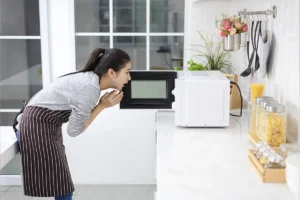
Microwave Repair Warning Signs You Shouldn’t Ignore
Microwave Repair Warning Signs You Shouldn’t Ignore The Importance of Recognizing Microwave Issues Microwaves are essential kitchen appliances that help us prepare delicious meals for our loved ones and ourselves. Unfortunately, like any other home
